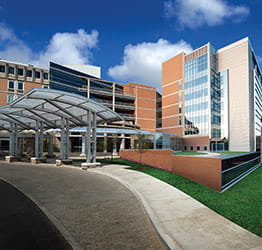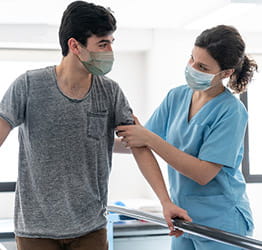
10/20/2025
PITTSBURGH – A wireless retinal implant can restore central vision in patients with advanced age-related macular degeneration (AMD), according to clinical trial results published today in the New England Journal of Medicine. Advanced atrophic AMD, also known as geographic atrophy (GA), is the leading cause of irreversible blindness in older adults, affecting more than 5 million people worldwide.
The international, multi-center trial was co-led by José-Alain Sahel, M.D., director of the UPMC Vision Institute, Daniel Palanker, Ph.D., professor of ophthalmology at Stanford University, and Frank Holz, M.D., professor of ophthalmology at the University of Bonn, Germany.
Of the 32 participants who completed 12 months of follow-up, 26 (81%) achieved clinically meaningful improvements in visual acuity, and 27 participants (84%) reported using prosthetic vision at home for reading numbers or words. On average, participants improved by 25 letters — about five lines — on a standard eye chart when using the device. 81% of participants gained 10 or more letters.
 “It’s the first time that any attempt at vision restoration has achieved such results in a large number of patients,” said Sahel, senior author of the study and chair of the Department of Ophthalmology at the University of Pittsburgh School of Medicine. “More than 80% of the patients were able to read letters and words, and some of them are reading pages in a book. This is really something we couldn’t have dreamt of when we started on this journey, together with Daniel Palanker, 15 years ago.”
“It’s the first time that any attempt at vision restoration has achieved such results in a large number of patients,” said Sahel, senior author of the study and chair of the Department of Ophthalmology at the University of Pittsburgh School of Medicine. “More than 80% of the patients were able to read letters and words, and some of them are reading pages in a book. This is really something we couldn’t have dreamt of when we started on this journey, together with Daniel Palanker, 15 years ago.”
As AMD progresses, the center of vision becomes increasingly blurry due to the irreversible damage to the light-sensing cells in the central part of the retina. In a healthy retina, those cells capture ambient light from the environment and transform it into pulses of electricity, which are then sent to nerve cells lining the back of the eye and, eventually, to the brain through the optic nerve.
The PRIMA system, originally designed by Palanker, replaces these lost photoreceptors with a 2×2 mm wireless implant that converts light into electrical signals to stimulate remaining retinal cells. A camera mounted on specialized glasses captures images and projects them onto the implant using invisible near-infrared light. The implant then converts the light into electrical pulses, restoring the flow of visual information to the brain. Patients can adjust zoom and contrast settings to enhance functional vision.
The PRIMAvera trial enrolled 38 participants aged 60 and older at 17 sites across five European countries: France, Germany, Italy, the Netherlands and the United Kingdom.
After one year of using the system, all procedure-related adverse events had subsided, and the majority of participants showed significant improvement in their ability to read letters on the eye chart. One participant improved by as many as 59 letters, or 12 lines.
“While we can’t yet restore full 20/20 vision with the implant alone, at UPMC we are investigating methods that could further improve people’s quality of life and take them above the threshold for legal blindness,” Sahel said.
Based on the results of the new study, the device manufacturer, Science Corporation, has applied for clinical use authorization in Europe and the United States. UPMC was the first U.S. center to implant the PRIMA device in 2020 in a study led by associate professor of ophthalmology Joseph Martel, M.D.
Other authors of the study include investigators at The University of Bonn; The Adolphe de Rothschild Foundation Hospital and The 15-20 National Eye Hospital, Paris; Moorfields Eye Hospital, London; and University of Rome Tor Vergata, among others.
The study was financed by Science Corporation, Alameda, Calif., (previously Pixium Vision SA, Paris, France).
PHOTO DETAILS: click image for high-res version
Caption: Jose Alain Sahel, M.D., holding the PRIMA implant
Credit: UPMC
















